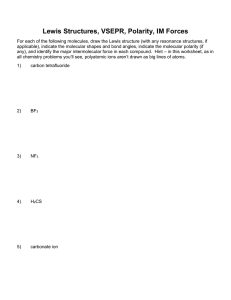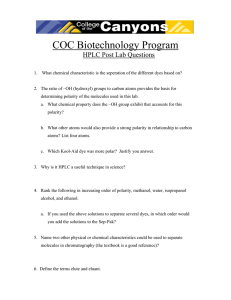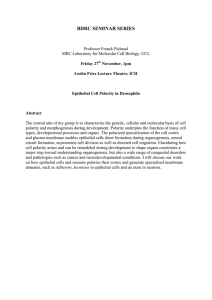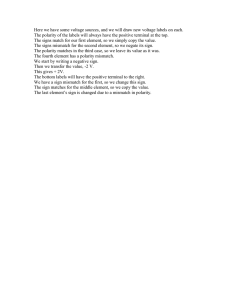polarity and phase 1
advertisement
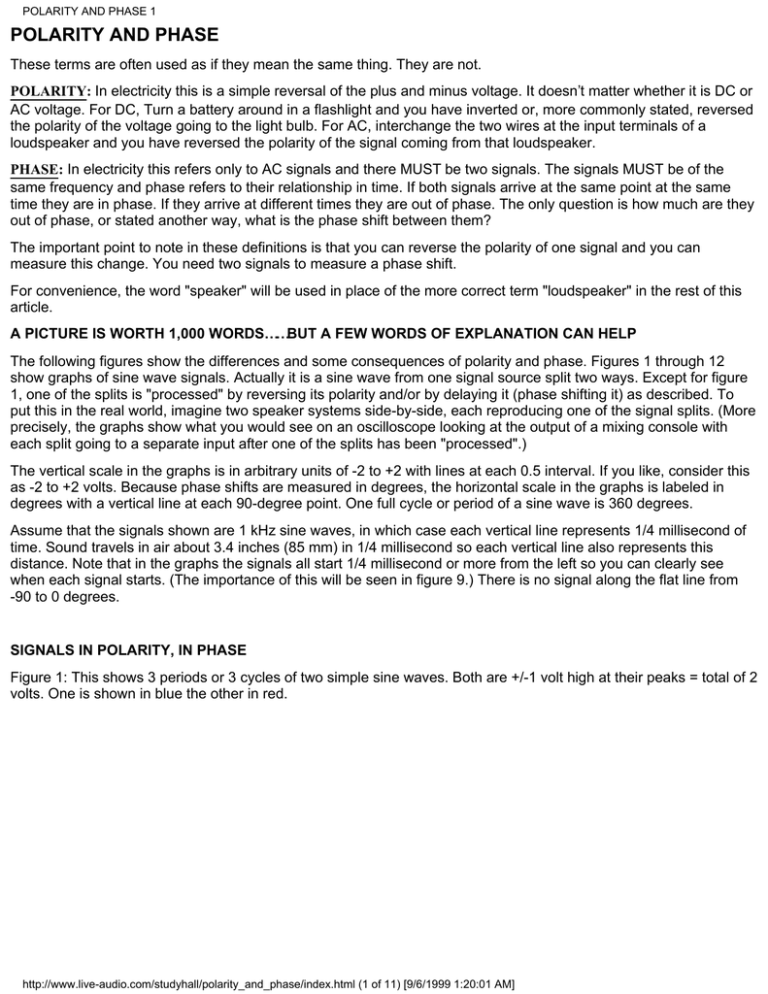
POLARITY AND PHASE 1 POLARITY AND PHASE These terms are often used as if they mean the same thing. They are not. POLARITY: In electricity this is a simple reversal of the plus and minus voltage. It doesn’t matter whether it is DC or AC voltage. For DC, Turn a battery around in a flashlight and you have inverted or, more commonly stated, reversed the polarity of the voltage going to the light bulb. For AC, interchange the two wires at the input terminals of a loudspeaker and you have reversed the polarity of the signal coming from that loudspeaker. PHASE: In electricity this refers only to AC signals and there MUST be two signals. The signals MUST be of the same frequency and phase refers to their relationship in time. If both signals arrive at the same point at the same time they are in phase. If they arrive at different times they are out of phase. The only question is how much are they out of phase, or stated another way, what is the phase shift between them? The important point to note in these definitions is that you can reverse the polarity of one signal and you can measure this change. You need two signals to measure a phase shift. For convenience, the word "speaker" will be used in place of the more correct term "loudspeaker" in the rest of this article. A PICTURE IS WORTH 1,000 WORDS……BUT A FEW WORDS OF EXPLANATION CAN HELP The following figures show the differences and some consequences of polarity and phase. Figures 1 through 12 show graphs of sine wave signals. Actually it is a sine wave from one signal source split two ways. Except for figure 1, one of the splits is "processed" by reversing its polarity and/or by delaying it (phase shifting it) as described. To put this in the real world, imagine two speaker systems side-by-side, each reproducing one of the signal splits. (More precisely, the graphs show what you would see on an oscilloscope looking at the output of a mixing console with each split going to a separate input after one of the splits has been "processed".) The vertical scale in the graphs is in arbitrary units of -2 to +2 with lines at each 0.5 interval. If you like, consider this as -2 to +2 volts. Because phase shifts are measured in degrees, the horizontal scale in the graphs is labeled in degrees with a vertical line at each 90-degree point. One full cycle or period of a sine wave is 360 degrees. Assume that the signals shown are 1 kHz sine waves, in which case each vertical line represents 1/4 millisecond of time. Sound travels in air about 3.4 inches (85 mm) in 1/4 millisecond so each vertical line also represents this distance. Note that in the graphs the signals all start 1/4 millisecond or more from the left so you can clearly see when each signal starts. (The importance of this will be seen in figure 9.) There is no signal along the flat line from -90 to 0 degrees. SIGNALS IN POLARITY, IN PHASE Figure 1: This shows 3 periods or 3 cycles of two simple sine waves. Both are +/-1 volt high at their peaks = total of 2 volts. One is shown in blue the other in red. http://www.live-audio.com/studyhall/polarity_and_phase/index.html (1 of 11) [9/6/1999 1:20:01 AM] POLARITY AND PHASE 1 Figure 2: This is what happens when the two are combined (= added together). This is exactly what would happen on a line exactly between the two side-by-side speakers. The two signal beings being in phase and in polarity add up so the peaks are now at the +/- 2 volt lines = 4 volts or twice the original signals. Acoustically this is an increase of 6 dB = 20 x log(1+1). SIGNALS OUT OF POLARITY Figure 3: This is like figure 1 but the second sine wave, shown in red, has been reversed in polarity. As you can see the + and - voltage points are exactly opposite from the first sine wave, shown in blue. This would be accomplished by reversing the +/- input connection on the speaker reproducing the red sine wave. http://www.live-audio.com/studyhall/polarity_and_phase/index.html (2 of 11) [9/6/1999 1:20:01 AM] POLARITY AND PHASE 1 Figure 4: This is what happens when the two are combined. Each point of the two signals being in phase, but opposite polarity, adds up to zero. Acoustically this is an infinite decrease of output. Because you can’t take the log of 0 assume the difference is actually 0.0 .01 volts (the dots = 58 more zeros). 20 x log of this number is -1200 dB. That should be pretty quiet. You can’t easily hear this with two speakers because of having two ears. But using a very carefully positioned microphone to measure this in a place with no sound reflections, you would find almost no signal. SIGNALS OUT OF PHASE Figure 5: The second sine wave, shown in red, starts 1/4 millisecond later (90 degrees later) than the first one, shown in blue. Put another way, the second signal has been delayed by 1/4 millisecond. http://www.live-audio.com/studyhall/polarity_and_phase/index.html (3 of 11) [9/6/1999 1:20:01 AM] POLARITY AND PHASE 1 Figure 6: This is what happens when the two are combined and it’s pretty interesting. First notice that the peaks are almost at the +/-1.5 volt lines. The value is actually +/-1.414 volts. This is a 3 dB increase. This would be like listening to two speakers but the one reproducing the red sine wave is 3.4 inches (85 mm) further away from you than the other. The first thing you hear is only from the speaker reproducing the blue sine wave. The black line starts when the sound from the second speaker is heard and this line is the combined signal of both speakers. Suppose the speaker reproducing the red signal were only 2.25 inches (57 mm) further away. The signals would be shifted by only 60 degrees. The increase for the combined signal would be about 4.5 dB. So the amount of phase shift is important. The second thing to notice is what happens at 1/4 millisecond or 90 degrees after the blue signal starts when the second signal "kicks" into the picture represented by the line turning black. There is a distinct change in the waveform. The third thing to notice is that the entire waveform after the "glitch" is shifted in time compared to figure 7 about 45 degrees = average of 0 and 90 degrees. SIGNALS OUT OF PHASE AND POLARITY Figure 7: The second sine wave, shown in red, is a combination of the sine wave in figures 3 and 5. The signal not only has its polarity reversed but it is shifted in phase by 90 degrees compared to the first signal, shown in blue. In this case the speaker reproducing the red sine wave has its +/- input connection reversed in polarity and is 3.4 inches (85 mm) further away from you than the one reproducing the blue sine wave. http://www.live-audio.com/studyhall/polarity_and_phase/index.html (4 of 11) [9/6/1999 1:20:01 AM] POLARITY AND PHASE 1 Figure 8: This is what happens when the two signals are combined. The picture is similar to figure 6 with two important differences. First the "glitch" at the point where the second signal starts is different. This is the point where the line turns black. Second is that the entire waveform is shifted by 45 degrees again but this time to the left of the original signal. THE "GLITCHES" The glitches in figures 6 and 8 give an indication of what happens during the onset of a signal. While the so-called steady state portion of the combined signal (shown by the black portion of the lines) looks the same except for the amplitude change, these glitches will affect the transient attack of sounds. This is not to say that either will sound horrible, but a phase shift between otherwise identical replicas of a sound WILL make a difference in the sound of the initial transient attacks, depending on the frequency and amount of phase shift. This is exactly the kind of phenomena that can occur in the crossover region of a speaker. This is because the distance from each driver to the listener is usually different and the crossover itself shifts the phase of the signal between the drivers. Speaker designers are often faced with a choice between something like what you see in figures 6 and 8. Neither is "correct" so a designer can only choose the one that "listens" better. Just looking at these two, I would bet the waveform in figure 8 might sound better and the choice would be to reverse the polarity of one of the drivers. These crossover "glitches" occur only over a small range of frequencies where both drivers reproduce the sound. It is well accepted by designers that this kind of "improvement" is sonically more significant than the fact that frequencies above and below the crossover point may be out of polarity. SIGNAL PHASE SHIFTED 180 DEGREES http://www.live-audio.com/studyhall/polarity_and_phase/index.html (5 of 11) [9/6/1999 1:20:01 AM] POLARITY AND PHASE 1 This is where many get into trouble in thinking that phase and polarity are the same thing, meaning that it is often assumed that a 180 degree phase shift and reversing the polarity are the same. Figure 9: In this figure each sine wave lasts for only 2-1/2 cycles. The second sine wave, shown in red, is shifted in phase 180 degrees from the first shown in blue. This is what would happen if the speaker reproducing the red sine wave were about 6.8 inches (170 mm) further away from you than the one reproducing the blue sine wave. You can see that between the 180 and 900 degrees the signals LOOK like they are simply out of polarity but they are NOT. It is VERY important to note that if you could not see the beginning or the end of these signals you could not tell whether they were out of polarity or 180 degrees out of phase. Too often this is what causes confusion between a polarity reverse and a 180 degree phase shift. Figure 10: This is the result of combing the two signals. Unlike figure 4 where the signals are simply out of polarity, and completely cancel, there are clearly two positive halves of a sine wave visible before and after the two signals cancel along the black line between 180 and 900 degrees. The first is from the blue sine wave in figure 9 that occurs before the start of the red sine wave. The second is from the red sine wave in figure 9 that continues after the blue sine wave stopped. SIGNAL PHASE SHIFTED 180 DEGREES AND REVERSED IN POLARITY Figure 11: This is the same as figure 9 but the polarity of the red signal is reversed from figure 9. http://www.live-audio.com/studyhall/polarity_and_phase/index.html (6 of 11) [9/6/1999 1:20:01 AM] POLARITY AND PHASE 1 Figure 12: This is the two signals in figure 11 combined. Between the 180 and 900 degrees, the signals add much like in figure 2. However there are significant differences in the overall 90 to 1080 degree signal. The first 1/2 sine wave of this signal is only from the blue sine wave from figure 11. The last 1/2 sine wave is only from the red sine wave in figure 11. You can clearly see that both of these 1/2 sine waves are only 1 volt at the peaks. This is a clear difference from figure 2 where all the peaks reach 2 volts. The reason is that the two signals in figure 11, even though identical, are offset by 180 degrees. They add together only between 180 and 900 degrees when both are being heard. More importantly, during this time period DIFFERENT parts of the same signal have added together. For example you can see that between 180 and 360 degrees it is the second 1/2 of the blue signal’s first complete sine wave that adds to the first 1/2 of the red signal’s first complete sine wave. REAL AUDIO SIGNALS Sine waves are easy to look at to dramatically show the difference between polarity and phase. Armed with this knowledge you can look at figures 13 through 18 that show something like a real audio signal where the effects of polarity and phase are more difficult to see. The signal shown in these figures was a generated by a mathematical algorithm that produces something close to a pink noise signal. Pink noise contains all frequencies with an equal amount of energy in each octave band. Real audio signals don’t look much different than pink noise (but one would hope they sound better!). The scales on these graphs are arbitrary. You can look at the vertical scales as +/-3 volts if you like. However, because of the way the signal was generated, there was no way to define absolute time or degrees along the horizontal scales. Suffice it to http://www.live-audio.com/studyhall/polarity_and_phase/index.html (7 of 11) [9/6/1999 1:20:01 AM] POLARITY AND PHASE 1 say that the phase-shifted signal used in these figures was shifted by one data point out of the 240 data points that make up the signal lines. There is one important thing to understand about phase shift. The amount of time one signal is delayed from another will have different effects at different frequencies. Assume there is a 1 millisecond time difference between two identical signals. At 500 Hz the result will be as shown in figure 10 because at 500 Hz the 1 millisecond time difference is a phase shift of 180 degrees. The signals are offset by 1/2 a cycle. At 1 kHz the signals will be offset by 1 complete cycle. In other words you would hear one cycle from the first signal then both combine then you’d hear the one cycle from the second signal after the first stopped. This is similar to what is shown in figure 12 (which shows only 1/2 cycle) but is not the result of the same conditions that were used to make figure 12. At 250 Hz the effect would be as shown in figure 6 because a 1 millisecond time difference corresponds to a 90 degree phase shift at 250 Hz or an offset of 1/4 cycle. At lower frequencies the phase shift would be even less and the signals would tend to add as in figure 2, approaching but never quite reaching the 6 dB increase shown in that figure. Contrary to phase, polarity affects all frequencies the same way. It makes the positive portions negative and the negative portions positive. Put another way, it simply flips the signal over the same way at all frequencies. With these things in mind, examine figures 12 through 18 EFFECTS OF POLARITY AND PHASE ON "REAL" AUDIO SIGNALS Figure 13: This shows a pink noise signal generated as noted above. Figure 14: This shows both the original signal in blue and what happens when an identical but phase shifted signal is added to it, as shown in red. The red signal is similar to the combined signal shown in figure 6. Note the increases in signal level and the changes in the waveform (many glitches). However you can also see the combined signal follows the original fairly closely. http://www.live-audio.com/studyhall/polarity_and_phase/index.html (8 of 11) [9/6/1999 1:20:01 AM] POLARITY AND PHASE 1 Figure 15: This shows both the original signal in blue and what happens when the phase shifted signal is also reversed in polarity and combined with it, as shown in red. In this case there are huge differences between the original and combined signal. Figure 16: To better understand what is going on, this figure shows an averaged or integrated version of the pink noise signal in figure 13. This is basically what would you would see if you graphed the readings from a typical SPL meter for the signal in figure 13. Figure 17: This shows the averaged signal from figure 16, in blue, and the averaged combined signal from figure 14, in red. Note that there are primarily level differences (mostly increases). Otherwise the two lines look very similar. http://www.live-audio.com/studyhall/polarity_and_phase/index.html (9 of 11) [9/6/1999 1:20:01 AM] POLARITY AND PHASE 1 Figure 18: This really shows what is going on in figure 15. The blue line is the averaged signal from figure 16. The red line is the averaged signal from figure 15. The red line shows that the out of polarity and phase-shifted signal approaches a straight line. Because you are looking at a broad frequency range, you are seeing a severe cancellation of the lower frequencies due to the polarity reversal. However, unlike the low frequencies, the upper frequencies do not completely cancel due to the phase shift. The red line contains primarily high frequency energy. In the blue signal the higher frequencies are the small "bumps". These can be clearly seen in the red signal and most of them correspond to those in the blue signal. Figure 18 is a prime example of what you would hear if you stand exactly between two speakers playing the same signal (i.e. mono) with one speaker out of polarity. The bass will disappear. But, there will always be a difference in distance between you and the speakers due to the spacing of your two ears and probably a slight overall difference in distance between you and each speaker. A difference in distance means a difference in the time arrival and thus there will be phase shifts between the sound from the two speakers. The amount of shift will vary with frequency. Because of the shorter wavelengths at high frequencies, the phase shifts allow most of the highs to be heard. They may be out of polarity but the effect is like what is shown in figure 8. Also, in a room you would also hear sound reflections from the floor, walls, and ceiling. You would only hear something like the red line in figure 18 outdoors away from any reflective surfaces or in an anechoic chamber. The small distance between your ears and any small difference in distance from you to each speaker do not cause appreciable phase shifts at low frequencies. This is because of the considerably larger wavelengths. The difference in your distance from each speaker might be only 1 inch (25 mm). However, the wavelength of even a 1 kHz sound is roughly 1 foot (300 mm) and at 100 Hz roughly 10 feet (3 m). At the lower frequencies the polarity difference predominates because the phase shifts due to the difference in your distance from the speakers is very small compared to the wavelengths of the low frequencies. Thus the lower frequency signals, being nearly in phase but out of polarity, will cancel like in figure 4. The lower the frequency the less the phase shift between the two speakers and the greater the cancellation. A POLARITY / PHASE FIELD TRIP!! (As with all physical exercise, check with your doctor first, who might not recommend you do this for some reason.) http://www.live-audio.com/studyhall/polarity_and_phase/index.html (10 of 11) [9/6/1999 1:20:01 AM] POLARITY AND PHASE 1 Find two railroad tracks, lie across them, and wait. Two trains, one on each track, come along. Both are right side up and both hit you at exactly the same time. The trains are in polarity and in phase. The same thing happens again and both trains hit you at exactly the same time. However, this time one train is upside down. That is a polarity reversal. The third time both trains are right side up but one hits you first and the other hits you shortly after the first. That is a phase shift. The last time the second train is upside down and hits you later than the first. That is both a polarity reversal and a phase shift. SUMMARY So there you have it. Although this has only touched on a few areas concerning phase and polarity issues, it is hoped you better understand the difference between the two and a few of the effects of each. Remember that the audio frequency range covers wavelengths of over 30 feet (10 meters) at the lowest frequencies to less than an inch (under 25 mm) at the highest frequencies. While a reversal of polarity will affect all frequencies identically, a difference in time arrival between two otherwise identical signals will have very different effects on the phase between them. The amount of phase shift will be different at different frequencies and this will depend on how much time difference there is between the arrival of the two signals. Chuck McGregor http://www.live-audio.com/studyhall/polarity_and_phase/index.html (11 of 11) [9/6/1999 1:20:01 AM]

